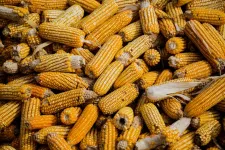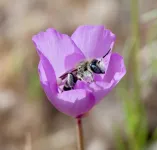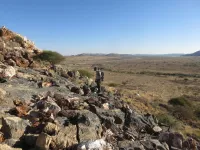(Press-News.org) One-third of the fertilizer applied to grow corn in the U.S. each year simply compensates for the ongoing loss of soil fertility, leading to more than a half-billion dollars in extra costs to U.S. farmers every year, finds new research from the University of Colorado Boulder published last month in Earth's Future.
Long-term soil fertility is on the decline in agricultural lands around the world due to salinization, acidification, erosion and the loss of important nutrients in the soil such as nitrogen and phosphorus. Corn farmers in the U.S. offset these losses with nitrogen and phosphorus fertilizers also intended to boost yields, but scientists have never calculated how much of this fertilizer goes into just regaining baseline soil fertility--or how much that costs.
"We know there's land degradation going on even in U.S. modern agriculture, but it's really difficult to pin down how much and what impact it has," said Jason Neff, corresponding author on the paper and director of the Sustainability Innovation Lab at Colorado (SILC). "These findings provide more information to farmers so they can make decisions that benefit them economically, but also support a more sustainable form of high-yield agriculture."
The U.S. is one of the most productive countries in the world when it comes to corn, growing more than 4.46 tons per acre farmed. In the 2018-19 growing season alone, U.S. farms produced more than 366 million metric tons of corn which generated $14.5 billion in revenue. The U.S. is also one of the world's largest users of fertilizer, applying more nitrogen and phosphorus per acre than its high-yield agricultural counterparts in the European Union.
But using fertilizer doesn't just cost farmers and governments money. It also comes at an environmental cost. A large portion of the global greenhouse gas emissions caused by agriculture--24% of global emissions in 2010 and 10% of U.S. emissions in 2018--comes from fertilizer production. This means that steps taken to reduce fertilizer use also help address rising greenhouse gases.
Excess nitrogen and phosphorus that runs off fields and into rivers and lakes also creates unhealthy conditions for freshwater and marine life, and is responsible for the Dead Zone in the Gulf of Mexico--a large area depleted of oxygen and devoid of ocean life, including many commercially important species. When we consider not only dollars spent by farmers but also nutrient loss and impacts to the Mississippi River, the costs go from billions to over a trillion dollars every year, said Neff.
"If you can drop the fertilization, while maintaining the yields that we need and the economic outcomes that farmers want, then why not, right? That's a win-win," said Neff.
Untangling the true cost of fertilizer
To separate out this true cost of fertilizer from other modern agricultural inputs, Neff and his colleagues ran a series of scenario-based model analyses using the Environmental Policy Integrated Climate (EPIC) model, a widely used agronomic model used to estimate crop growth and how crop growth responds to variables like fertilizer, irrigation and climate.
"Doing that lets us then untangle, what's going on with degradation," he said. "What's going on when you change a system from natural to agricultural, and how much of an impact does that have on the nutrients available for plant growth?"
The researchers used four scenarios in this model to compare how using no fertilizer or irrigation--as is in done in many developing economies--differed from using only one or the other, or both (which is common practice in the U.S.). Irrigation was an important component of the analyses because while it can increase yields, it also increases erosion and fertilizer runoff.
By separating the impacts of fertilizer and irrigation, the researchers could see in different regions of the U.S. where each was more important than the other for agricultural success. In California, farmers add more water. In Ohio, fertilizer additions are more important than irrigation. But across the country, they found that it took a whopping one third of fertilizer presently added to cornfields to simply break even, bringing soil fertility back to pre-farmed levels.
Farming smarter
While this may sound like bad news, Neff sees it as a golden opportunity: with more information, farmers can make better decisions.
"Farmers do what makes sense to grow crops. When you're not able to see the cumulative effects of degradation, you have to add fertilizers but you're not going to know what the financial impact of that underlying degradation is," said Neff.
Practices like regenerative agriculture, which restore soil fertility on lands actively being farmed, will also reduce the costs and environmental impacts of fertilizer use. Healthier, more fertile soils can also capture more carbon, hold more water and keep excess nutrients from running off into ecosystems that can't handle them.
Farmers can reduce how often they till their fields, add and increase erosion control measures, as well as use more organic fertilizers, like compost. These can actually help reduce the amount of inorganic fertilizers--nitrogen and phosphorus--needed in the soil.
"My hope is that this information supports national and international efforts to build back soil fertility," said Neff.
INFORMATION:
Additional authors on this paper include first author W. S. Jang of Division for Public Infrastructure Assessment, Environmental Assessment Group, Korea Environment Institute (KEI); Y. Im of the Ulsan National Institute of Science and Technology (UNIST); L. Doro with the Blackland Research and Extension Center, Texas A&M AgriLife Research; and J. E. Herrick with the USDA-Agricultural Research Service.
Every field has its underlying principles. For economics it's the rational actor; biology has the theory of evolution; modern geology rests on the bedrock of plate tectonics.
Physics has conservation laws and symmetries. For instance, the law of conservation of energy - which holds that energy can neither be created nor destroyed -- has guided research in physics since antiquity, becoming more formalized as time went on. Likewise, parity symmetry suggests that switching an event for its mirror image shouldn't affect the outcome.
As physicists have worked to understand the truly bizarre rules ...
Most flowering plants depend on pollinators such as bees to transfer pollen from the male anthers of one flower to the female stigma of another flower, enabling fertilization and the production of fruits and seeds. Bee pollination, however, involves an inherent conflict of interest, because bees are only interested in pollen as a food source.
"The bee and the plant have different goals, so plants have evolved ways to optimize the behavior of bees to maximize the transfer of pollen between flowers," explained Kathleen Kay, associate professor of ecology ...
COLUMBUS, Ohio - For those trying to live a healthy lifestyle, the choice between sugar and artificial sweeteners such as saccharin can be confusing. A new study led by researchers at The Ohio State University Wexner Medical Center and The Ohio State University College of Medicine found the sugar substitute saccharin doesn't lead to the development of diabetes in healthy adults as previous studies have suggested.
The study findings are published in the journal Microbiome.
"It's not that the findings of previous studies are wrong, they just didn't adequately control for things like ...
LA JOLLA, CALIF. - Jan 12, 2020 - Scientists at Sanford Burnham Prebys Medical Discovery Institute have identified the sensor in human lungs that detects SARS-CoV-2 and signals that it's time to mount an antiviral response. The study, published today in Cell Reports, provides insights into the molecular basis of severe disease and may enable new strategies for the treatment and prevention of COVID-19.
"Our research has shown that MDA-5 is the immune cop that's tasked to keep an eye out for SARS-CoV-2 and call for back-up," says Sumit Chanda, Ph.D., director of the Immunity and Pathogenesis Program at Sanford Burnham Prebys and senior author of ...
Family courts are misunderstanding and misusing research around how children form close relationships with their caregivers, say an international group of experts.
Seventy experts from across the globe argue that widespread misunderstandings around attachment research have hampered its accurate implementation, with potentially negative consequences for decisions in family courts.
In response, they have published an international consensus statement in Attachment & Human Development that aims "to counter misinformation and help steer family court applications of attachment theory in a supportive, evidence-based direction on matters related to child protection and custody decisions".
In the statement, the group sets out three principles from attachment research ...
Philadelphia, January 12, 2021 - A special issue of the Journal of the American College of Radiology (JACR), published by Elsevier, challenges conventional wisdom across the imaging community. This collection of articles, the "Provocative Issue," presents extreme opinions on pressing issues confronting radiologists with the deliberate aim of sparking positive dialog and debate that will lead to innovative solutions to improve patient care and imaging-related outcomes.
The issue is guest-edited by:
Caroline Chung, MD, MSc, Director of Advanced ...
ATLANTA - JANUARY 12, 2021 - Overall cancer death rates in the United States dropped continuously from 1991 through 2018 for a total decrease of 31%, including a 2.4% decline from 2017 to 2018. The news comes from the American Cancer Society's annual Cancer Statistics, 2021 article, appearing in CA: A Cancer Journal for Clinicians, and its consumer version, Cancer Facts & Figures 2021. This year marks the American Cancer Society's 70th anniversary of reporting this data to inform the nation's fight against cancer.
The report estimates that in the U.S. in 2021, almost 1.9 million (1,898,160) new cancer cases will be diagnosed and 608,570 Americans will die from cancer. ...
Remarkably well-preserved fossils are helping scientists unravel a mystery about the origins of early animals that puzzled Charles Darwin.
Analysis of the 547 million-year-old remains has enabled researchers to trace the ancestry of some of the world's earliest animals further back than ever before.
Their study has uncovered the first known link between animals that evolved during the so-called Cambrian Explosion some 540 million-years-ago and one of their early ancestors.
Until recently, little was known about the origins of animals that evolved during the Cambrian event because of a lack of well-preserved fossil evidence.
The mysterious origins of animals that evolved at this time - when the diversity ...
Core technology includes promising bivalent single-domain antibodies simultaneously targeting two surface structures of the viral spike protein.
Lead candidates DIOS-202 and DIOS-203 are engineered for high potency and their potential to avoid the emergence of escape mutants.
DIOS-202 and DIOS-203 entered into accelerated development to initiate clinical studies later this year.
BONN, Germany, January 12, 2021 - DiosCURE SE announced a publication in Science describing its core technology of multivalent single-chain antibodies with a unique molecular mode-of-action to inactivate ...
While most people are able to eat a normal diet, many of those managing distinct nutritional requirements related to a disease or health condition rely on medical foods. Medical foods help patients meet their nutritional needs, often improving nutritional and health outcomes and quality of life. A recent publication in Current Developments in Nutrition, titled "Medical Foods: Science, Regulation, and Practical Aspects. Summary of a Workshop," shares the historical and regulatory context of medical foods and perspectives on their role in the future.
Medical foods help patients manage their nutritional needs, yet it can be very difficult for patients to have access to them. In August 2019, the Healthcare Nutrition Council (HNC), in partnership with the American Society ...





